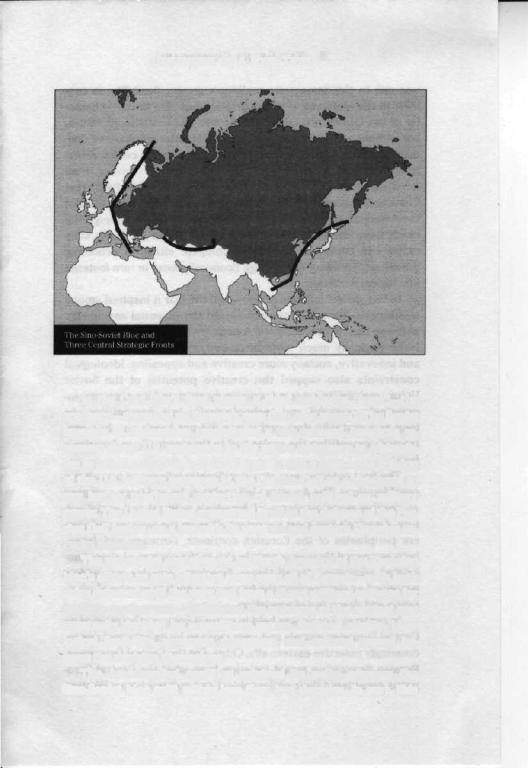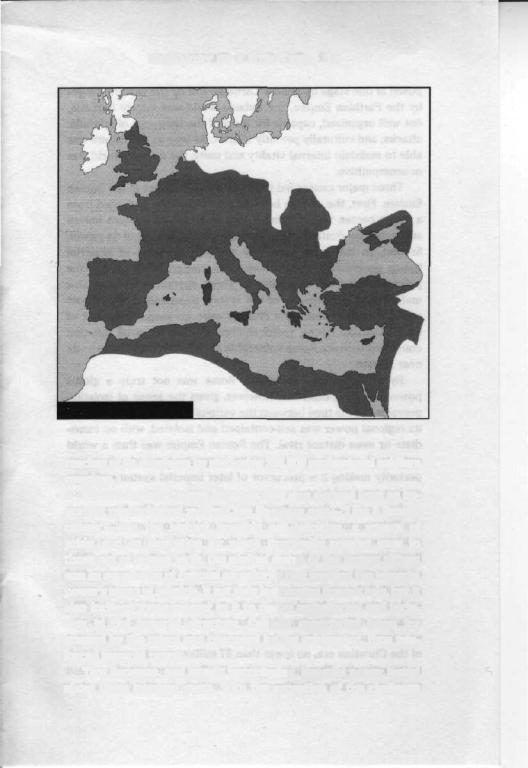
Grand_Chessboard
.pdf
CHAPTER 1
Hegemony
of a
New Type
HEGEMONY is AS OLD AS MANKIND. But America's current global supremacy is distinctive in the rapidity of its emergence, in its global scope, and in the manner of its exercise. In the
course of a single century, America has transformed itself—and has also been transformed by international dynamics—from a country relatively isolated in the Western Hemisphere into a power of unprecedented worldwide reach and grasp.
THE SHORT ROAD TO GLOBAL SUPREMACY
The Spanish-American War in 1898 was America's first overseas war of conquest. It thrust American power far into the Pacific, beyond Hawaii to the Philippines. By the turn of the century, American strategists were already busy developing doctrines for a two-ocean naval supremacy, and the American navy had begun to challenge the notion that Britain "rules the waves." American claims of a special status as the sole guardian of the Western Hemisphere's secu- rity—proclaimed earlier in the century by the Monroe Doctrine
3

4 THE GRAND CHESSBOARD
and subsequently justified by America's alleged "manifest des- tiny"—were even further enhanced by the construction of the Panama Canal, which facilitated naval domination over both the Atlantic and Pacific Oceans.
The basis for America's expanding geopolitical ambitions was provided by the rapid industrialization of the country's economy. By the outbreak of World War I, America's growing economic might already accounted for about 33 percent of global GNP, which displaced Great Britain as the world's leading industrial power. This remarkable economic dynamism was fostered by a culture that favored experimentation and innovation. America's political institutions and free market economy created unprecedented opportunities for ambitious and iconoclastic inventors, who were not inhibited from pursuing their personal dreams by archaic privileges or rigid social hierarchies. In brief, national culture was uniquely congenial to economic growth, and by attracting and quickly assimilating the most talented individuals from abroad, the culture also facilitated the expansion of national power.
World War I provided the first occasion for the massive projection of American military force into Europe. A heretofore relatively isolated power promptly transported several hundred thousand of its troops across the Atlantic—a transoceanic military expedition unprecedented in its size and scope, which signaled the emergence of a new major player in the international arena. Just as important, the war also prompted the first major American diplomatic effort to apply American principles in seeking a solution to Europe's international problems. Woodrow Wilson's famous Fourteen Points represented the injection into European geopolitics of American idealism, reinforced by American might. (A decade and a half earlier, the United States had played a leading role in settling a Far Eastern conflict between Russia and Japan, thereby also asserting its growing international stature.) The fusion of American idealism and American power thus made itself fully felt on the world scene.
Strictly speaking, however, World War I was still predominantly a European war, not a global one. But its self-destructive character marked the beginning of the end of Europe's political, economic, and cultural preponderance over the rest of the world. In the course of the war, no single European power was able to prevail

HEGEMONY OF A NEW TYPE 5
decisively—and the war's outcome was heavily influenced by the entrance into the conflict of the rising non-European power, America. Thereafter, Europe would become increasingly the object, rather than the subject, of global power politics.
However, this brief burst of American global leadership did not produce a continuing American engagement in world affairs. Instead, America quickly retreated into a self-gratifying combination of isolationism and idealism. Although by the mid-twenties and early thirties totalitarianism was gathering strength on the European continent, American power—by then including a powerful two-ocean fleet that clearly outmatched the British navy—re- mained disengaged. Americans preferred to be bystanders to global politics.
Consistent with that predisposition was the American concept of security, based on a view of America as a continental island. American strategy focused on sheltering its shores and was thus narrowly national in scope, with little thought given to international or global considerations. The critical international players were still the European powers and, increasingly, Japan.
The European era in world politics came to a final end in the course of World War II, the first truly global war. Fought on three continents simultaneously, with the Atlantic and the Pacific Oceans also heavily contested, its global dimension was symbolically demonstrated when British and Japanese soldiers—repre- senting, respectively, a remote Western European island and a similarly remote East Asian island—collided thousands of miles from their homes on the Indian-Burmese frontier. Europe and Asia had become a single battlefield.
Had the war's outcome been a clear-cut victory for Nazi Germany, a single European power might then have emerged as globally preponderant. (Japan's victory in the Pacific would have gained for that nation the dominant Far Eastern role, but in all probability, Japan would still have remained only a regional hegemon.) Instead, Germany's defeat was sealed largely by the two ex- tra-European victors, the United States and the Soviet Union, which became the successors to Europe's unfulfilled quest for global supremacy.
The next fifty years were dominated by the bipolar AmericanSoviet contest for global supremacy. In some respects, the contest

6 THE GRAND CHESSBOARD
between the United States and the Soviet Union represented the fulfillment of the geopoliticians' fondest theories: it pitted the world's leading maritime power, dominant over both the Atlantic and the Pacific Oceans, against the world's leading land power, paramount on the Eurasian heartland (with the Sino-Soviet bloc encompassing a space remarkably reminiscent of the scope of the Mongol Empire). The geopolitical dimension could not have been clearer: North America versus Eurasia, with the world at stake. The winner would truly dominate the globe. There was no one else to stand in the way, once victory was finally grasped.
Each rival projected worldwide an ideological appeal that was infused with historical optimism, that justified for each the necessary exertions while reinforcing its conviction in inevitable victory. Each rival was clearly dominant within its own space—unlike the imperial European aspirants to global hegemony, none of which ever quite succeeded in asserting decisive preponderance within Europe itself. And each used its ideology to reinforce its hold over its respective vassals and tributaries, in a manner somewhat reminiscent of the age of religious warfare.
The combination of global geopolitical scope and the proclaimed universality of the competing dogmas gave the contest unprecedented intensity. But an additional factor—also imbued with global implications—made the contest truly unique. The advent of nuclear weapons meant that a head-on war, of a classical type, between the two principal contestants would not only spell their mutual destruction but could unleash lethal consequences for a significant portion of humanity. The intensity of the conflict was thus simultaneously subjected to extraordinary self-restraint on the part of both rivals.
In the geopolitical realm, the conflict was waged largely on the peripheries of Eurasia itself. The Sino-Soviet bloc dominated most of Eurasia but did not control its peripheries. North America succeeded in entrenching itself on both the extreme western and extreme eastern shores of the great Eurasian continent. The defense of these continental bridgeheads (epitomized on the western "front" by the Berlin blockade and on the eastern by the Korean War) was thus the first strategic test of what came to be known as the Cold War.

HEGEMONY OF A NEW TYPE 7
In the Cold War's final phase, a third defensive "front"—the southern—appeared on Eurasia's map (see map above). The Soviet invasion of Afghanistan precipitated a two-pronged American response: direct U.S. assistance to the native resistance in Afghanistan in order to bog down the Soviet army; and a large-scale buildup of the U.S. military presence In the Persian Gulf as a deterrent to any further southward projection of Soviet political or military power. The United States committed itself to the defense of the Persian Gulf region, on a par with its western and eastern Eurasian security interests.
The successful containment by North America of the Eurasian bloc's efforts to gain effective sway over all of Eurasia—with both sides deterred until the very end from a direct military collision for fear of a nuclear war—meant that the outcome of the contest was eventually decided by nonmilitary means. Political vitality, ideological flexibility, economic dynamism, and cultural appeal became the decisive dimensions.
The American-led coalition retained its unity, whereas the Sino-Soviet bloc split within less than two decades. In part, this

8 THE GRAND CHESSBOARD
was due to the democratic coalition's greater flexibility, in contrast to the hierarchical and dogmatic—but also brittle—charac- ter of the Communist camp. The former involved shared values, but without a formal doctrinal format. The latter emphasized dogmatic orthodoxy, with only one valid interpretative center. America's principal vassals were also significantly weaker than America, whereas the Soviet Union could not indefinitely treat China as a subordinate. The outcome was also due to the fact that the American side proved to be economically and technologically much more dynamic, whereas the Soviet Union gradually stagnated and could not effectively compete either in economic growth or in military technology. Economic decay in turn fostered ideological demoralization.
In fact, Soviet military power—and the fear it inspired among westerners—for a long time obscured the essential asymmetry between the two contestants. America was simply much richer, technologically much more advanced, militarily more resilient and innovative, socially more creative and appealing. Ideological constraints also sapped the creative potential of the Soviet Union, making its system increasingly rigid and its economy increasingly wasteful and technologically less competitive. As long as a mutually destructive war did not break out, in a protracted competition the scales had to tip eventually in America's favor.
The final outcome was also significantly influenced by cultural considerations. The American-led coalition, by and large, accepted as positive many attributes of America's political and social culture. America's two most important allies on the western and eastem peripheries of the Eurasian continent, Germany and Japan, both recovered their economic health in the context of almost unbridled admiration for all things American. America was widely perceived as representing the future, as a society worthy of admiration and deserving of emulation.
In contrast, Russia was held in cultural contempt by most of its Central European vassals and even more so by its principal and increasingly assertive eastern ally, China. For the Central Europeans, Russian domination meant isolation from what the Central Europeans considered their philosophical and cultural home: Western

HEGEMONY OF A NEW TYPE 9
Europe and its Christian religious traditions. Worse than that, it meant domination by a people whom the Central Europeans, often unjustly, considered their cultural inferior.
The Chinese, for whom the word "Russia" means "the hungry land," were even more openly contemptuous. Although initially the Chinese had only quietly contested Moscow's claims of universality for the Soviet model, within a decade following the Chinese Communist revolution they mounted an assertive challenge to Moscow's ideological primacy and even began to express openly their traditional contempt for the neighboring northern barbarians.
Finally, within the Soviet Union itself, the 50 percent of the population that was non-Russian eventually also rejected Moscow's domination. The gradual political awakening of the non-Russians meant that the Ukrainians, Georgians, Armenians, and Azeris began to view Soviet power as a form of alien imperial domination by a people to whom they did not feel culturally inferior. In Central Asia, national aspirations may have been weaker, but here these peoples were fueled in addition by a gradually rising sense of Islamic identity, intensified by the knowledge of the ongoing decolonization elsewhere.
Like so many empires before it, the Soviet Union eventually imploded and fragmented, falling victim not so much to a direct military defeat as to disintegration accelerated by economic and social strains. Its fate confirmed a scholar's apt observation that
[ejmpires are inherently politically unstable because subordinate units almost always prefer greater autonomy, and counter-elites in such units almost always act, upon opportunity, to obtain greater autonomy. In this sense, empires do not fall; rather, they fall apart, usually very slowly, though sometimes remarkably quickly.'
'Donald Puchala. "The History of the Future of International Relations,"
Ethics and International Affairs 8 (1994):183.

10 THE GRAND CHESSBOARD
THE FIRST GLOBAL POWER
The collapse of its rival left the United States in a unique position. It became simultaneously the first and the only truly global power. And yet America's global supremacy is reminiscent in some ways of earlier empires, notwithstanding their more confined regional scope. These empires based their power on a hierarchy of vassals, tributaries, protectorates, and colonies, with those on the outside generally viewed as barbarians. To some degree, that anachronistic terminoJogy is not altogether inappropriate for some of the states currently within the American orbit. As in the past, the exercise of American "imperial" power is derived in large measure from superior organization, from the ability to mobilize vast economic and technological resources promptly for military purposes, from the vague but significant cultural appeal of the American way of life, and from the sheer dynamism and inherent competitiveness of the American social and political elites.
Earlier empires, too, partook of these attributes. Rome comes first to mind. Its empire was established over roughly two and a half centuries through sustained territorial expansion northward and then both westward and southeastward, as well as through the assertion of effective maritime control over the entire shoreline of the Mediterranean Sea. In geographic scope, it reached its high point around the year A.D. 211 (see map on page 11). Rome's was a centralized polity and a single self-sufficient economy. Its imperial power was exercised deliberately and purposefully through a complex system of political and economic organization. A strategically designed system of roads and naval routes, originating from the capital city, permitted the rapid redeployment and concentration—in the event of a major security threat—of the Roman legions stationed in the various vassal states and tributary provinces.
At the empire's apex, the Roman legions deployed abroad numbered nu less than three hundred thousand men—a remarkable force, made all the more lethal by the Roman superiority in tactics and armaments as well as by the center's ability to direct relatively rapid redeployment. Qt is striking to note that in 1996, the vastly more populous supreme power, America, was protecting the outer

HEGEMONY OF A NEW TYPE 11
MRKmnan Empire a\ Its Height
reaches of its dominion by stationing 296,000 professional soldiers overseas.)
Rome's imperial power, however, was also derived from an important psychological reality. Civis Romanus sum—"I am a Roman citizen"—was the highest possible self-definition, a source of pride, and an aspiration for many. Eventually granted even to those not of Roman birth, the exalted status of the Roman citizen was an expression of cultural superiority that justified the imperial power's sense of mission. It not only legitimated Rome's rule, but it also inclined those subject to it to desire assimilation and inclusion in the imperial structure. Cultural superiority, taken for granted by the rulers and conceded by the subjugated, thus reinforced imperial power.
That supreme, and largely uncontested, imperial power lasted about three hundred years. With the exception of the challenge

12 THE GRAND CHESSBOARD
posed at one stage by nearby Carthage and on the eastern fringes by the Parthian Empire, the outside world was largely barbaric, not well organized, capable for most of the time only of sporadic attacks, and culturally patently inferior. As long as the empire was able to maintain internal vitality and unity, the outside world was noncompetitive.
Three major causes led to the eventual collapse of the Roman Empire. First, the empire became too large to be governed from a single center, but splitting it into western and eastern halves automatically destroyed the monopolistic character of its power. Second, at the same time, the prolonged period of imperial hubris generated a cultural hedonism that gradually sapped the political elite's will to greatness. Third, sustained inflation also undermined the capacity of the system to sustain itself without social sacrifice, which the citizens were no longer prepared to make. Cultural decay, political division, and financial inflation conspired to make Rome vulnerable even to the barbarians in its near abroad.
By contemporary standards, Rome was not truly a global power but a regional one. However, given the sense of isolation prevailing at the time between the various continents of the globe, its regional power was self-contained and isolated, with no immediate or even distant rival. The Roman Empire was thus a world unto itself, with its superior political organization and cultural superiority making it a precursor of later imperial systems of even greater geographic scope.
Even so, the Roman Empire was not unique. The Roman and the Chinese empires emerged almost contemporaneously, though neither was aware of the other. By the year 221 B.C. (the time of the Punic Wars between Rome and Carthage), the unification by Chin' of the existing seven states Into the first Chinese empire had prompted the construction of the Great Wall in northern China, to seal off the inner kingdom from the barbarian world beyond. The subsequent Han Empire, which had started to emerge by 140 B.C., was even more impressive in scope and organization. By the onset of the Christian era, no fewer than 57 million people were subject to its authority. That huge number, itself unprecedented, testified to extraordinarily effective central control, exercised through a
